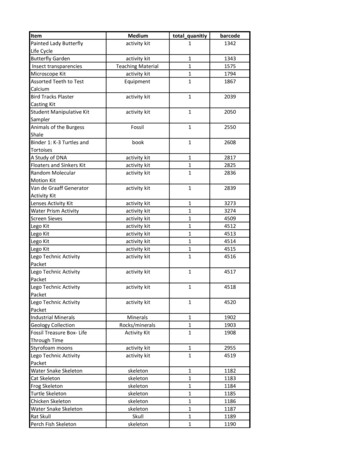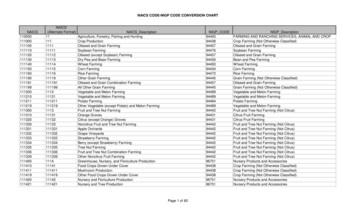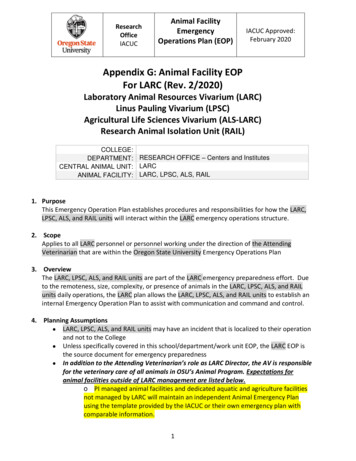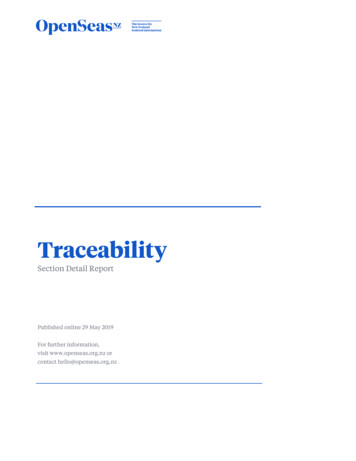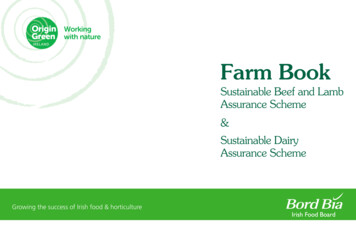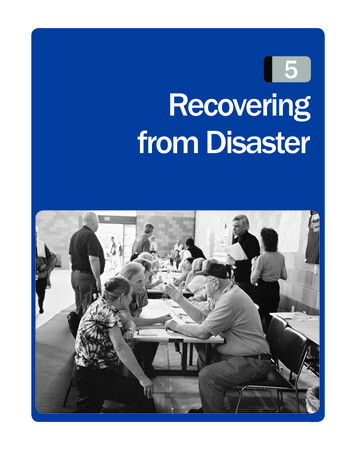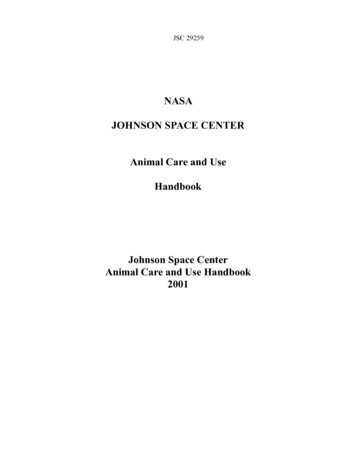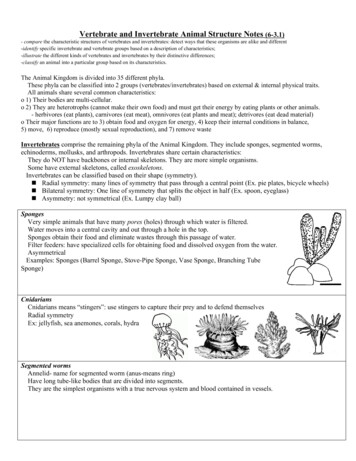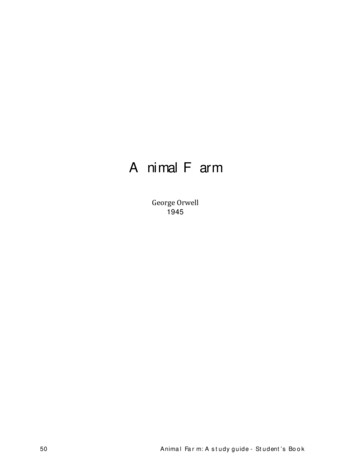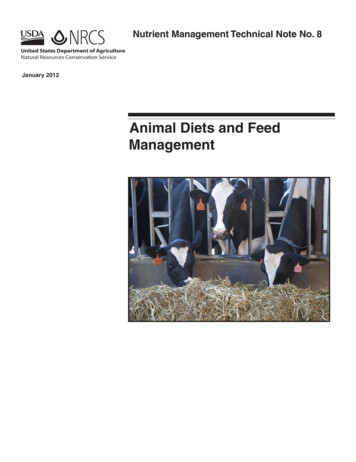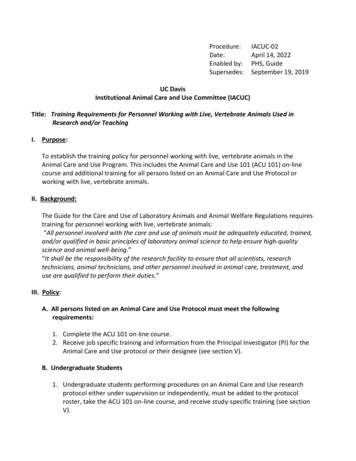
Transcription
ISSN 1810-073214FAO ANIMAL PRODUCTION AND HEALTHproceedingsCHALLENGES OF ANIMAL HEALTHINFORMATION SYSTEMSAND SURVEILLANCE FORANIMAL DISEASES AND ZOONOSES
Cover photographs:Center: FAO/Alessandra BenedettiRight: FAO/Asim HafeezLeft: FAO/P. Fong
14FAO ANIMAL PRODUCTION AND HEALTHproceedingsCHALLENGES OF ANIMAL HEALTHINFORMATION SYSTEMSAND SURVEILLANCE FORANIMAL DISEASES AND ZOONOSESFOOD AND AGRICULTURE ORGANIZATION OF THE UNITED NATIONSRome, 2011
Recommended CitationFAO. 2011. Challenges of animal health information systems and surveillance for animal diseases andzoonoses. Proceedings of the international workshop organized by FAO,23-26 November 2010, Rome, Italy. FAO Animal Production and Health Proceedings, No. 14. Rome, Italy.The designations employed and the presentation of material in this informationproduct do not imply the expression of any opinion whatsoever on the partof the Food and Agriculture Organization of the United Nations (FAO) concerning thelegal or development status of any country, territory, city or area or of its authorities,or concerning the delimitation of its frontiers or boundaries. The mention of specificcompanies or products of manufacturers, whether or not these have been patented, doesnot imply that these have been endorsed or recommended by FAO in preference toothers of a similar nature that are not mentioned. The views expressed in this informationproduct are those of the author(s) and do not necessarily reflect the views of FAO.ISBN 978-92-5-107034-5All rights reserved. FAO encourages reproduction and dissemination of material inthis information product. Non-commercial uses will be authorized free of charge.Reproduction for resale or other commercial purposes, including educational purposes,may incur fees. Applications for permission to reproduce or disseminate FAO copyrightmaterials and all other queries on rights and licences, should be addressed by e-mail tocopyright@fao.org or to the Chief, Publishing Policy and Support Branch, Office ofKnowledge Exchange, Research and Extension, FAO, Viale delle Terme di Caracalla,00153 Rome, Italy. FAO 2011
iiiContentsAcronymsviiIntroduction1Group discussion and recommendations5Surveillance for the present and the future15Jeffrey C. Mariner, Dirk U. Pfeiffer, Solenne Costard, Lea Knopf, James Zingeser,Dickens Chibeu, Jane Parmley, Monica Musenero, Cyrille Pisang, Samuel Okuthe,Peter Bloland, Christine C. Jost, Saskia Hendrickx and Purvi MehtaSurveillance for animal diseases and animal health informationmanagement in Australia19Graeme GarnerProgress and challenges in official information systemsfor disease surveillance in Chile23Gustavo SotomayorAnimal health information systems in Indonesia25SoegiartoAnimal health information system in Viet Nam29Van Dang KyAnimal Resources Information System (ARIS) of the AU-IBAR31Dickens M ChibeuGlobal surveillance: suggestions for a strategic approach33L. M. GrangerDigital pen technology for animal disease surveillance in Southern Africa39Mokganedi MokopasetsoActive surveillance of H5N1 HPAI using sms gateway in Bangladesh41Mat Yamage and Mahabub AhmedSurveillance for rinderpest: beyond eradication43Felix NjeumiThe german animal disease notification and information systemsStaubach C, Klöß D, Kowalczyk S, Kramer M, Kranz P, Micklich A, Probst C, Schröder R,and Conraths FJ49
ivSADC animal health and livestock network53Cleopas BamhareOIRSA data collection system for animal and plant health55Marcela MarchelliSIVCONT epidemiological information and surveillance system57A. J. Mendes da Silva, E. Brasil, V. E. Saraiva, G. C. Darsie and J. NaranjoREPIVET: epidemiosurveillance network of REMESA63B. Molina-FloresCaribvet: a regional animal health surveillance network65Thierry LefrançoisWildlife disease surveillance and reporting69F. Joshua DeinFAO EMPRES-i Asia: regional animal disease information system for Asia71Beibei JiaInformation systems and surveillance for animal diseasesin saarc countries73Mohinder OberoiPROMED: global early warning system for animal,plant and human diseases75Peter Cowen, Fabian N. Ekue, O.O. Babalobi, Marjorie P. Pollack, Alison Bodenheimer,Lawrence C. Madoff and the ProMED-mail teamLaboratory Information Management System (LIMS)in Australia and Indonesia77Peter Durr, James Watson and SoegiartoFAO/OIE FMD Reference Laboratories Information System: ReLais83Donald P. King, Paul-Michael Agapow, John B Bashiruddin, Nick J. Knowles,David J. Paton and Jef HammondOFFLU’s contribution to global animal influenza surveillance85Filip Claes, Mia Kim and Gwenaelle DauphinBioPortal: a web-based system for global surveillance of animal diseases89B. Brito , Z. Whedbee, M. Alkhamis, R. Carrasco, M. Thurmond and A. PerezSurveillance needs, tools and options: experiences betweendeveloped and developing worlds91Angus CameronTADinfoAkiko Kamata95
vGlobal Administrative Unit Layers (GAUL)99Fabio GritaFAO wildlife disease surveillance101Jennifer Siembieda, Tracy McCracken and Scott H. NewmanThe OIE World Animal Health Information System (WAHIS)103Karim Ben JebaraEvent management at WHO: an all hazards approach109Bernadette Abela and Johannes SchnitzlerThe FAO/OIE/WHO Global Early Warning System113Julio Pinto (FAO), Karim Ben Jebara (OIE), Daniel Chaisemartin (OIE),Stephane de La Rocque (FAO) and Bernadette Abela (WHO)FAO EMPRES-i: an integrated tool for early warningand animal disease surveillance115Julio Pinto, Sophie Von Dobschuetz, Guillaume Kondolas, Fairouz Larfaouiand Christopher Hamilton-WestList of participants117
viiAcronymsAAHLAustralian Animal Health LaboratoryADMAS-Epitrak India’s own disease information softwareAFENETAfrican Field Epidemiology NetworkAHAAnimal Health AustraliaAIAvian InfluenzaAIEMUAvian Influenza Emergency Management UnitARISAnimal Resources Information SystemARIS1PACE Integrated Database (PID)AU-IBARAfrican Union Interafrican Bureau for Animal ResourcesAVSAdditional Veterinary Surgeons - BangladeshBioSIRTBiosecurity Surveillance, Incident, Response and Tracing - AustraliaBMELVFederal Ministry of Food, Agriculture and Consumer Protection -GermanyCADDBCentralized Animal Disease Database - GermanyCADMSCentre for Animal Disease Modelling and Surveillance - University ofCalifornia, Davis, USCAHWCommunity Animal Health WorkerCAPCaribbean Amblyomma Programme (to eradicate the tropical bont tick)CaribVETCaribbean Animal Health NetworkCEAHCentres for Epidemiology and Animal Health - USCMC-AHCrisis Management Centre-Animal HealthCRISAustralian Client Resource Information SystemCSFClassical Swine FeverCVOChief Veterinary OfficerDAHDepartment for Animal Health - Viet NamDGLSGovernment Directorate General of Livestock Services - Indonesia
viiiDICDisease Investigation Centres (Type-A regional veterinary laboratorieswith comprehensive testing capabilities) - IndonesiaDTPDigital Pen TechnologyEADExotic Animal DiseaseEDISEpidemic Disease Information System - AustraliaELISAEnzyme-linked Immunosorbent AssayEMS(WHO) Event Management SystemEMPRES-i(FAO) Emergency Prevention Systems for Transboundary Animal andPlants Pests and Diseases (Web-based platform developed by EMPRES)FANRFood, Agriculture and National Resources Directorate of IADCFAOFood and Agriculture Organization of the UNFLIFriedrich Loeffler Institute in Wusterhausen - GermanyFMDFoot-and-mouth diseaseGAINSGlobal Animal Information SystemGAULGlobal Administrative Unit Layers (developed by FAO to address theinternational community’s need for harmonized global informationabout administrative units)GISGeographic Information SystemGLEWSGlobal Early Warning System for Major Animal Diseases, includingZoonosesGOARNGlobal Outbreak Alert and Response NetworkGPHINGlobal Public Health Intelligence NetworkGREPGlobal Rinderpest Eradication ProgrammeHAIHuman-Animal InterfaceHPAIH5N1 Highly Pathogenic Avian InfluenzaIAEAInternational Atomic Energy AgencyICD(WHO) International Classification of DiseasesIEFSIndependent Emergency Field Server - AustraliaIHR(WHO) International Health RegulationsILRIInternational Livestock Research Institute
ixINFOSAN(WHO/FAO) International Food Safety Authorities NetworkIOMInstitute of MedicineISIDInternational Society for Infectious DiseasesKIDSKey Indicator data system (built-in mapping unction for EMPRES –developed by FAO Computer Service)LDCCLocal Disease Control centresLIMSLaboratory Information Management SystemLIMSLivestock Information Management SystemLTCLivestock Technical CommitteeMARDMinistry of Agriculture and Rural Development - Viet NamMOHMinistry of Health - Viet NamNACANetwork of Aquaculture Centres in Asia PacificNADRESNational Animal Disease Referral Expert System - IndiaNAHISNational Animal Health Information System - AustraliaNAHLNNational Animal Health Laboratory Network - USNAHRSNational Animal Health Reporting System (for US reportable diseasesplus comprehensive reporting system for OIE)NAHSSNational Animal Health Surveillance System - USNAMPinfoNational Arbovirus Monitoring Programme - AustraliaNCVDNational Centre for Veterinary Diagnostics - Viet NamNFPNational Focus PointsNGONon Governmental OrganizationNLRADNational List of Reportable Animal Diseases (draft list held by CEAH ofnotifiable or monitored diseases) - USNVAPNational Veterinary Accreditation Program – USOIEWorld Organization for Animal HealthOIRSAOrganismo Internacional Regional de Sanidad Agropecuaria(International Regional Organization for Plant and Animal Health)PACEPan African programme for the Control of EpizooticsPANAFTOSAPan American FMD Centre
xPARCPan African Rinderpest CampaignPARCOChilean Certification of Premises under Official ControlPCPProgressive Control Pathway (for FMD)PDSRParticipatory Disease Surveillance and Response ProgrammePENAPHParticipatory Epidemiology Network for Animal and Public HealthPIDPACE Integrated Database (ARIS1)PPRPeste des Petits RuminantsPRRSHighly Virulent Porcine Reproductive and Respiratory Syndrome RAHC-NARegional Animal Health Centre - North AfricaRAHORegional Animal Health Offices - Viet NamRECRegional Epidemiology CentreRECOMSAAnimal Health Communication NetworkREMESAMediterranean Animal Health Network (Algeria, Egypt, France, Italy,Libya, Morocco, Mauritania, Portugal, Spain and Tunisia)RELABSAAnimal Health Laboratory NetworkReLaISReference Laboratories Information System (for FMD)REPIVETVeterinary Epidemiosurveillance NetworkRESEPSAAnimal Health Socio-Economic and Production System NetworkRIACSOUN Regional Inter-Agency Coordination and Support OfficeRICAZInter American Meeting on FMD and Zoonoses ControlRMPResource Management Package - AustraliaRVCRoyal Veterinary College - UKRVFRift Valley FeverSAARCSouth Asian Association of Regional Cooperation (Afghanistan,Bangladesh, Bhutan, India, Nepal, Pakistan and Sri Lanka)SADCSouthern African Development Community (Angola, Malawi,Mozambique, Namibia, Tanzania, Zambia, Zimbabwe)SAGAnimal Protection Division of the Agriculture and Livestock Service of ChileSCIVContinental Epidemiological Information and Surveillance System -South America
xiSEStomatitis-EnteritisSIBSwiss Institute for Bio-InformaticsSIKHNASSistem Informasi Kesehatam Hewan Nasional (National InformationSystem for Animal Health)- IndonesiaSIPECLivestock Information System - ChileSIVCONTWeb platform application installed at PANAFTOSA servers, supportingSCIV to improve timeliness of information when sanitary events occurSNIVNational Information and Surveillance Systems - South AmericaSPCSecretariat of the Pacific CommunitySPSSanitary and PhytosanitarySQCRSurveillance, Quarantine, Control and Recovery - AustraliaSQLStructured Query LanguageSTARSSample Tracking and Reporting System – AustraliaSTVSpatio-Temporal VisualizerTADTransboundary Animal DiseaseTSNTier Seuchen-Nachrichten (National Animal Disease Reporting System) -GermanULAVLocal Veterinary Care Field UnitULOUpazila (Subdistrict) Livestock Officer - BangladeshUS-CDCUnited States Centres for Disease Control and PreventionVEEVenezuelan Equine EncaphalongelitisVSVeterinary ServicesWAHIDWorld Animal Health Information DatabaseWANWide Area NetworkWHOWorld Health OrganisationWRLFMDWorld Reference Laboratory for FMD - Purbright, UKXMLExtensible Markup Language
1IntroductionThe international workshop organized by FAO on the Challenges of National, Regional andGlobal Information Systems and Surveillance for Major Animal Diseases and Zoonoses tookplace in Rome from 23 to 26 November 2010. Forty-four experts from around the worldmade a series of presentations over three days on different aspects of collective global animal health promotion, animal diseases surveillance and disease prevention systems. A broadarray of international and regional organizations, national veterinary, medical and otherhealth-related services, academic institutions and non-profit organizations were involved.This report summarizes the conference participants’ discussions on surveillance andinformation systems, and explores issues raised in the presentations. The focus is on theoperation, characteristics, objectives, conceptual design, needs and future directions fornational, regional and global animal health surveillance and information systems.The workshop was based on the following principles: Disease surveillance designed to reduce disease burden and poverty is a global publicgood. Health information systems should be designed to cross geographic boundaries andto encompass human and animal health, where appropriate, because pathogens donot respect geographic or species differences. Early detection and early warning are of paramount importance in allowing healthsystems to respond to events, reduce risk and mitigate the consequences of diseaseemergence.ObjectivesFour objectives were articulated for the workshop participants:1. Identify successes achieved by current national, regional and global surveillance systems, and propose means to overcome challenges – including strategies to facilitatedata sharing and technology transfer between national, regional and global healthinformation systems.2. Discuss standardizing mechanisms for exchanging data between information systems, by encouraging the use of open source software and technologies.3. Identify appropriate ways to improve collection, management, analysis and use ofgeoreferenced data on transboundary animal diseases (TADs), zoonoses and otheremerging diseases.4. Seek consensus on protocols for sharing official and unofficial data between national,regional and global animal health information systems.This workshop report is presented in two parts, encompassing the deliberations of thegroup. The first part is a summary of discussion points and recommendations, and the second part presents the results of an informal but structured survey that ranked participants’perceptions of global surveillance and information needs.
2Challenges of animal health information systems and surveillance for animal diseases and zoonosesThe effective containment and control of epidemic diseases depends on early notification of disease events or outbreaks, and the capacity to forecast the spread of pathogensto new areas. Emergent zoonoses include H5N1 Highly Pathogenic Avian Influenza (HPAI)or Rift Valley Fever (RVF) and other transboundary threats such as Foot-and-Mouth Disease(FMD), Highly Virulent Porcine Reproductive and Respiratory Syndrome (PRRS) in South EastAsia and Peste des Petits Ruminants (PPR) in Eastern Africa.Early warning of animal disease outbreaks with a known zoonotic potential enableshealth authorities to advise at-risk populations. Public health measures – including behaviours to be avoided and controls to prevent human illness and mortality – can be implemented. For many zoonotic diseases, animals not only harbour the pathogens but act toamplify their effects, increasing the risk for humans. The effects of endemic diseases andepidemics in livestock impact, food security, food safety, people’s livelihoods and trade,with the accompanying potential for disruption in each of these arenas alongside the animal and human suffering involved when an epidemic takes hold.Timely and good-quality information about disease events are needed in order to understand the disease situation, support decision-making, prevent potential disease incursionand respond quickly in an emergency situation. A system that allows information-sharingamong relevant agencies at national and regional levels is of vital importance, underpinning cooperation in the ongoing surveillance of disease pathogens and the human-animalhealth interface. Different agencies are involved in human health, animal health, agricultureand food safety but require shared access to the information available. Having access willenable them to ensure an integrated specific approach for understanding pathogen ecologies, and to develop control strategies for diseases such as zoonotic avian influenza – atnational, regional and international levels.Risk factors or drivers of disease emergence take agro-ecological practices and conditions into account, including land use, climate, demographics and economic data. Sharedanalysis of disease data therefore gets beyond the health status reported officially by countries and, in light of the mandates and information held by OIE and WHO, FAO is able tomake major contributions in identifying these drivers of disease emergence, trends, geogenetic mapping, socio-economic influences and agro-ecological zoning.Various tools for collecting information about animal health at national, regional andglobal levels have made significant contributions to the timely reporting of animal diseaseevents, and to analysing animal disease drivers and patterns of transmission and spread.Ongoing challenges relate to the sensitivity of surveillance systems for capturing information about new pathogens or old pathogen emergence. The proliferation in recent years ofofficial and non-official systems, such as ProMED and the Global Public Health IntelligenceNetwork (GPHIN), has been accompanied by different technologies, data requirements andstandards. Overlaps between national, regional and global information systems are evidentin some regions and most data relating to animal disease outbreaks are entered and processed at national, regional and global levels.Epidemiology and laboratory networks play an important role in gathering qualitydisease data and providing epidemiological interpretation. Linking outbreak informationwith data related to the pathogen characteristics can help in understanding disease andgenetic dynamics in their spatial and temporal context. Where information from national
Introductionand reference laboratories may not be available in the public domain, there is insufficientintegration of national, regional and global databases; and where availability of information may be constrained by political or trade implications, there are difficulties in sharingdisease data.FAO is actively developing country tools and software such as TADinfo to provide technical assistance to member states through developing and implementing national information systems, and creating global platforms such as EMPRES-i to collect animal diseaseinformation in the context of the agro-ecosystem parameters. These Web-based secureinformation systems – which are password-protected with individual privileges – serve asmanagement and analysis tools for animal health data and information, and as platformsfor sharing data and information on transboundary animal diseases (TADs) in agreementwith other national, regional and global animal health information systems. Informationstored can be easily adapted and transferred to other databases should parties agree.3
5Group discussion andrecommendationsA recurring theme in the group’s discussions was the recognition that good animalhealth surveillance combines the process of detection with the transformation tools forconverting rough data into information for taking action on disease control and riskmanagement.The group considered that, in addition to their traditional role in promoting animalhealth and production, surveillance systems provide important early warning and trackingof zoonotic diseases, identify emerging diseases, and promote international trade. Theimplicit recognition was that animal health surveillance is a global public good that spansmany sectors in our global economic system. Participants also recognized challenges forsurveillance at the human-domestic animal-wildlife interface, where ongoing surveillancehas usually been absent. Surveillance in wildlife populations is an important way of assessing specific ecosystem health and this information can help protect the broader environment in specific or threatened ecosystems.The group also turned its focus towards technical issues, acknowledging the value ofgeographic information systems, discussing analytic strategies to extract information fromthe large volume of data collected, and reaching conclusions about how to share dataamong animal and public health institutions and officials, how to incorporate open sourceplatforms, and how to disseminate results.Finally, a lack of capacity at national, regional and international levels, in many regions,was recognized. Given this starting point, finding the resources for effective surveillanceat all levels is a long-term and critical challenge to building better global health systems.An ongoing process of evaluating and improving objectives and standards is needed,along with capacity- building to ensure effective and efficient surveillance systems at everylevel. An important starting point is the existing global framework provided by the Foodand Agriculture Organization of the United Nations (FAO), the World Organisation forAnimal Health (OIE) and the World Health Organization (WHO) which together promoteongoing iterative processes of quality improvement.Participants indicated that OIE standards, such as the OIE Terrestrial Animal HealthCode, and WHO International Health Regulations (IHR) for disease reporting respond to themandates of each organization. They recommend that continuing efforts be made to assistFAO/OIE/WHO members to expand and improve their surveillance systems to include protecting livelihoods, improving and safeguarding food production, discovering disease, anddetecting and responding early to novel pathogens. Adding extra value to disease reporting mechanisms and feedback to countries providing data is imperative. International andregional bodies, in collaboration with research institutions, could facilitate epidemiologicalanalysis and risk assessment, and might usefully provide feedback reports to countries
6Challenges of animal health information systems and surveillance for animal diseases and zoonosesoriginating the data - as having their contributions recognized might well stimulate theirinterest and further collaboration.The participants recognized that the objectives of individual surveillance systems varywidely, depending on the needs and level of development of the country or countriesinvolved. There is also variation between local, subnational, national, regional and globalsurveillance systems. At a technical level, this variation can be harnessed by encouragingcommon standards for disease reporting in such areas as terminology, disease identificatio(ID), geocoding, and so on based on accepted international standards.To this end, data-sharing technology and terminology needs to be standardized incost-effective and robust ways. Databases must be flexible enough to accommodate localneeds and to incorporate new diseases and wildlife and zoonotic diseases of importance toa country. Harnessing existing components to create a comprehensive and sensitive surveillance system requires resources, and it is recommended that the international communitybuilds capacity at all levels to meet these standards and benchmarks.The group discussed the advantages of event-based surveillance as a platform to addon to more traditional surveillance systems. Event-based surveillance is the rapid and timelycollection of health events gathered through open source reporting. Traditional surveillance systems produce credible information but reporting is often delayed, which slowsresponse times; and these systems are typically built for known diseases, meaning thatdiseases without a confirmed etiology might not be picked up. Event-based surveillance, asa component of a wider surveillance system, could be an asset in monitoring the health ofwildlife populations which, as mentioned above, have traditionally lacked highly effectivesurveillance strategies.As a first step, the group proposed making an inventory of existing animal and publichealth databases – with a description of their structure, objectives, purpose and functions –so as to build on strengths and identify weaknesses. Participants proposed that open sourcedata handling systems should be explored carefully as offering the advantage of accessibility for many members, which is crucial for an effective global surveillance community. Validalternatives exist and the choice of data management tools depends on many factors.An ability to share information system source codes could promote an open system,aiding the development of an information platform where widely differing technologicaltools are blended together to make a robust, balanced, comprehensive global surveillancesystem broadly accessible to all stakeholders. Security of shared codes must be balancedin each situation, bearing in mind that open source programs can provide significant costadvantages and enable widespread adoption of common, integrated platforms capable ofamalgamating information from multiple surveillance systems.The group advocated the use and sharing of open source codes for disease databasedevelopment, using adequate filters or security features to prevent unauthorized data sharing. Database managers could share codes developed for public databases in the publicdomain but the risk of external users accessing sensitive information would need to bemitigated.Participants identified several challenges to the optimal performance of disease surveillance systems. These challenges sometimes interfere with effective monitoring and analysisof the animal health status of a particular geographic area or over a particular period of
Group discussion and recommendationstime, and include farmer reporting and compliance, links between laboratories and surveillance systems, the number and capacity of references centres, obtaining and sustaining anincrease in institutional support and resources, and absence of international standard codesfor names and terminology within a database.Key factors for successful surveillance systems identified by the group include a carefuldefinition of the purposes of the system, continuous redefinition of objectives and surveillance targets, an appropriate structure and flow of information, institutionalizing andformalizing the surveillance network, ongoing evaluation of the system’s effectiveness, definition of specific targets, and acceptability by users and stakeholders. Disease prioritizationhas to be based on geographical considerations, using ecosystem approaches to identifyareas or regions at risk and the potential impact of emerging or traditional animal diseases.Given that the nature of a response is generally aligned to the incentives and motivationssurrounding it, specific animal disease targets that are important for individual countriestend to result in better disease surveillance, control and mitigation.The role of decision-makers was highlighted during the discussions and politicalwill was identified as playing a strong role in disease surveillance since it is a top-downapproach that almost guarantees success, as in Rinderpest eradication and the joint FAO/OIE FMD progressive control pathway (PCP). The group also recognized that it is essential to raise awareness and involve local communities in disease surveillance activities toimprove the quality and accuracy of disease data. Communities in rural areas can implement disease surveillance programmes in cooperation with local stakeholders and villagebased action groups.In support of continuous improvements in surveillance systems at all levels, the groupproposed defining clear strategies to foster timely reporting, providing feedback to usersand stakeholders at all levels, and making data ownership transparent. Significant advocacyefforts are needed in order to build the required level of support. Case studies can demonstrate the value of an ongoing surveillance system that consumes significant resources; andcan promote the view among implementers and users of these systems that surveillance isa circular, iterative process that includes using system data to help define animal and publichealth goals based on need, in turn determining what additional or targeted data must becollected and analysed.The group indicated the important role of decision-makers in advocating the conceptof One Health - defined as a collaborative, international, cross-sectoral, multidisciplinarymechanism to address threats and reduce risks of detrimental infectious diseases at theanimal-human-ecosystem interface. Clarifying the roles of all contributors and users ofthe surveillance system and encouraging communication among them is also vital, so thatthey see the impact, knowledge, power and benefits that the analysis of surveillance datacan provide. Defining and adopting compelling incentives and understanding disincentivesshould be integral to participation at every level of the surveillance system.Participants recommended encouraging discussion about integrating informal andformal surveillance systems, a step that could provide multiple modalities for increasingthe robustness of national, regional and global surveillance systems. Informal surveillancesystems should be inter
Laboratory Information Management System (LIMS) in Australia and Indonesia 77 Peter Durr, James Watson and Soegiarto FAO/OIE FMD Reference Laboratories Information System: ReLais 83 Donald P. King, Paul-Michael Agapow, John B Bashiruddin, Nick J. Knowles, David J. Paton and Jef Hammond
